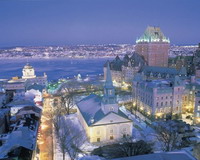Login form
Québec

You might be surprised to learn that most of Canada has two official languages. One is English. The other is French. You may need to know French if you want to understand a menu or a street sign in the province of Québec. Unlike the rest of Canada, Québec has only one official language.
Colonists from France settled Québec, starting in the 1600s. Today, most of Québec’s people have French ancestry. The province is serious about preserving its French heritage. Its laws forbid other languages from being used on local business signs unless French words are also given.
|
Facts About Québec |
|
|
|
|
|
Capital |
Québec |
|
Population |
7,510,000 people |
|
Rank among provinces and territories in population |
2nd |
|
Major cities |
Montréal, Québec |
|
Area |
595,000 square miles |
|
Rank among provinces and territories in area |
2nd |
|
Entry into federation |
July 1, 1867 |
|
Provincial bird |
Snowy Owl |
|
Provincial flower |
Blue Iris |
|
Abbreviation |
QC |
LA BELLE PROVINCE
Québec is located in eastern Canada. It is Canada’s largest province and is more than twice as big as the state of Texas in the United States. Québec covers about one-sixth of Canada’s total area. (The Canadian territory of Nunavut is larger, but it is not a province.)
To the people of Québec, it is La Belle Province (French for “The Beautiful Province”). The nickname refers to Québec’s splendid buildings and scenery.
THE ST. LAWRENCE RIVER
The St. Lawrence River cuts through the southern part of the province. Fertile lowlands and mountains lie on both sides of the river. Most of Québec’s people live in the St. Lawrence Lowlands.
North of Québec City, the St. Lawrence River widens. It becomes so wide that people call it la mer. That’s French for “the sea.”
Whales gather near the mouth of the St. Lawrence each summer to feed on fish and other seafood. Tourists gather in the Parc Marin du Saguenay-Saint-Laurent to watch the whales.
NORTHERN QUÉBEC
Most of Québec’s territory is far north. The northernmost part is cold, treeless tundra. The land remains frozen much of the year. Inuit live in villages in the far north.
South of the tundra are vast forests. Québec’s forests are full of wildlife, including black bears, caribou, moose, deer, beavers, and otters. The many lakes in the forests are filled with fish, ducks, and geese.
QUÉBEC CITY
Québec City is the capital of the province of Québec and the oldest city in Canada. It was founded in 1608 and has some of the oldest houses, churches, and streets in North America. Narrow, winding streets and old stone buildings make Québec City one of the most beautiful cities in North America.
Québec City is perched on a cliff high above the St. Lawrence River. A huge wall once enclosed Québec City and protected it from attackers. Parts of the wall remain. From it, you can look out on the city and the St. Lawrence River below.
There’s a fortress called the Citadel along the wall, at the highest point in Québec City. During the summer, troops perform a colorful ceremony called the changing of the guard at the Citadel. Near the edge of the cliff is the Château Frontenac. This luxury hotel was built in 1893 in the style of a French castle. It has become a city landmark.
MONTRÉAL
Montréal is the largest city in Québec and the second largest city in Canada. It is located on an island in the St. Lawrence River. Almost half of Québec’s total population lives in Montréal, including many of Québec’s English speakers. But Montréal is also the world’s second largest French-speaking city. Paris, the capital of France, comes first.
Montréal has many interesting buildings in both French styles and British styles. It is noted for its many churches. After visiting the city in 1881, American author Mark Twain noted that “You couldn’t throw a brick without breaking a church window.”
In 1967, Montréal hosted Expo ‘67, a big world’s fair. The event celebrated the 100th anniversary of Canada’s confederation—that is, its formation as a nation. In 1867, four British colonies united to form the Dominion of Canada. Québec was one of those colonies. More than 50 million tourists came to see Expo ‘67.
In 1976, Montréal hosted the Summer Olympic Games. Today, the Montréal Expos, the city’s major league baseball team, play in Olympic Stadium. The stadium was built for the Summer Olympics.
QUÉBEC’S FRENCH HERITAGE
French explorer Jacques Cartier sailed up the St. Lawrence River in 1535, establishing France’s connection with Québec. But France did not begin to colonize Québec until the 1600s. Québec takes its name from an Algonquian Indian word, kebek. It means “place where the river narrows” and describes a narrowing in the St. Lawrence near present-day Québec City. That’s where the French established their first settlement in North America.
By 1763, France had lost most of its North American territory to Britain. But French colonists stayed on. Today, most of Québec’s people are descended from those French colonists.
NOT QUITE A COUNTRY
The 1960s was a time of change in Québec. People began to take more pride in being citizens of Québec and part of its French heritage than in being Canadian. Québec’s flag flew in many more places than Canada’s national flag.
Québec enacted new laws to protect its French Canadian culture. Some people suggested that the province should separate from the rest of Canada. A movement for independence gained strength. The people of Québec voted on whether to separate from Canada in 1980 and again in 1995. Both times the idea was rejected—but by only a small number of votes.
Source: Microsoft ® Encarta

